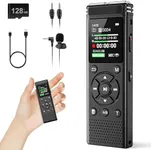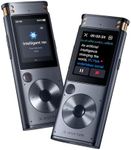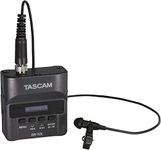Buying Guide for the Best Digital Voice Recorders
When choosing a digital voice recorder, it's important to consider your specific needs and how you plan to use the device. Whether you're a student needing to record lectures, a journalist capturing interviews, or someone who wants to document meetings, understanding the key specifications will help you make an informed decision. Here are the main features to look at and how to choose the best fit for you.Recording QualityRecording quality is measured in bit rates and sample rates, which determine how clear and detailed the recorded audio will be. Higher bit rates and sample rates mean better quality but also larger file sizes. If you need clear recordings for professional use, look for a recorder with high bit rates (128 kbps or higher) and sample rates (44.1 kHz or higher). For general note-taking or personal use, lower bit rates and sample rates may suffice.
Storage CapacityStorage capacity refers to how much audio the recorder can store. This is usually measured in gigabytes (GB). More storage means you can record longer sessions without needing to transfer files. If you plan to record long lectures or multiple interviews, look for a recorder with at least 4GB of storage. For occasional use, 2GB might be enough. Some recorders also offer expandable storage via SD cards, which can be a flexible option.
Battery LifeBattery life indicates how long the recorder can operate before needing a recharge or new batteries. Longer battery life is crucial for extended recording sessions. If you need to record for several hours at a time, look for a recorder with at least 10-15 hours of battery life. For shorter, more sporadic use, a recorder with 5-10 hours of battery life may be sufficient. Some models offer rechargeable batteries, which can be more convenient and cost-effective in the long run.
Microphone QualityThe quality of the built-in microphone affects how well the recorder captures sound. Higher-quality microphones can pick up more detail and reduce background noise. If you need to capture clear audio in noisy environments, look for a recorder with a high-quality, directional microphone. For general use in quiet settings, a standard microphone should be adequate. Some recorders also allow for external microphones, which can further enhance recording quality.
File FormatsDigital voice recorders save audio files in various formats, such as MP3, WAV, and WMA. MP3 files are compressed and take up less space, making them ideal for long recordings. WAV files are uncompressed and offer higher quality but take up more space. Choose a recorder that supports the file format that best suits your needs. If you need high-quality audio for professional purposes, WAV might be the best choice. For general use and easy sharing, MP3 is usually sufficient.
Ease of UseEase of use refers to how user-friendly the recorder is. Look for features like intuitive controls, a clear display, and simple file management. If you're not tech-savvy, a recorder with straightforward buttons and a basic interface will be easier to operate. For more advanced users, additional features like voice activation, bookmarking, and editing capabilities might be beneficial.
PortabilityPortability is about the size and weight of the recorder. A compact and lightweight recorder is easier to carry around, especially if you need to use it on the go. If you plan to carry the recorder in your pocket or bag, look for a small, lightweight model. For stationary use, such as in a classroom or office, size and weight may be less of a concern.





















